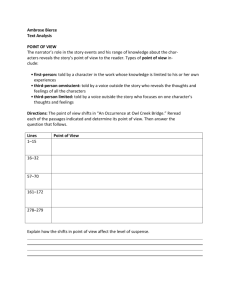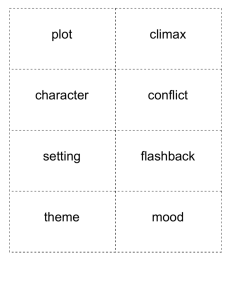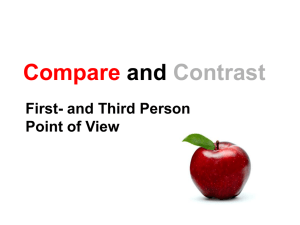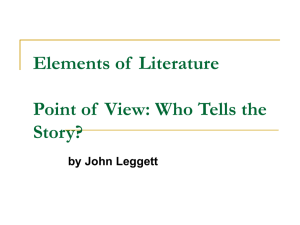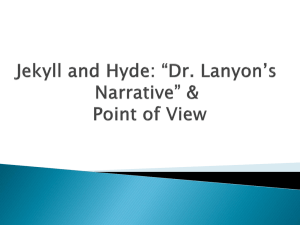The Narrator
advertisement
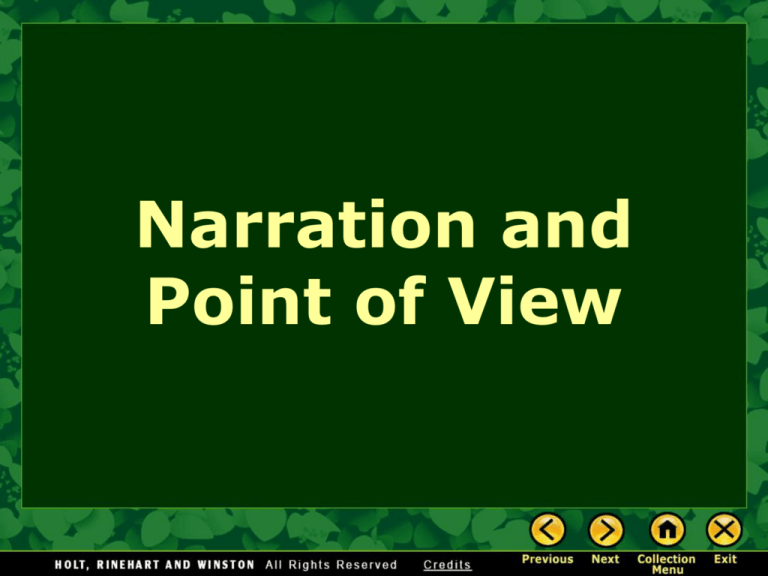
Narration and Point of View Narration and Point of View The narrator of the story is the person who is telling the story. There are 4 main types of narrators: 1. omniscient 2. first-person 3. third-person (limited) 4. objective A writer’s choice of a narrator determines the point of view of the story—the vantage point from which the story is told. The Narrator When you read a story, the narrator—the person telling the story—controls everything you know about the characters and events. Recognizing Narration in Text To recognize narration, look at the text that is not in “quotation marks”. Which text below is from the narrator? When he woke up that morning, he knew it was going to be a terrible day. He looked at his clock and noticed he had over-slept by 3 hours! “Oh man! I am so late!” he said to no one. After dressing and going to the kitchen for some breakfast, his mother sarcastically said, “Well, good afternoon, sleepy-head.” “I can’t believe I overslept,” he said in a disappointed voice. He started feeling upset, and wished he could go back to bed. Recognizing Narration in Text To recognize narration, look at the text that is not in “quotation marks”. Which text below is from the narrator? When he woke up that morning, he knew it was going to be a terrible day. He looked at his clock and noticed he had over-slept by 3 hours! “Oh man! I am so late!” he said to no one. After dressing and going to the kitchen for some breakfast, his mother sarcastically said, “Well, good afternoon, sleepy-head.” “I can’t believe I overslept,” he said in a disappointed voice. He started feeling upset, and wished he could go back to bed. Omniscient Point of View (pronounced: om-nish-ent) When the omniscient point of view is used, the narrator • is not a character in the story • is “all knowing” and knows what every character feels and thinks • can tell what’s happening in any setting in the story • knows every character’s back story Omniscient Point of View Quick Check One day a young woman looked out her apartment window and saw a man playing a saxophone. “Cool,” she thought as she swayed to his tune. A big brown dog joined the man and howled along with the music. Then a man in pajamas yelled from another window, complaining that the noise woke him up and he was going to call the police. This man, who worked the night shift and had to sleep all day, liked cats better than dogs anyway. The young saxophonist left. How can you tell this is an omniscient narrator? First-Person Point of View A first-person narrator • is a character in the story • uses first-person pronouns such as “I” and “me” when narrating. • tells us only what he or she thinks and experiences First-Person Point of View Quick Check “No way!” I said out loud as the sounds of a saxophone drifted in my bedroom window. I was finally dozing off when my neighbor started playing that stupid saxophone. I’d already been fired from one job because I fell asleep on the job, and now it’s probably going to happen again. I don’t know which sounds worse, that tone-deaf saxophonist or that yowling dog. I should call the police, I thought. How can you tell this is a firstperson narrator? Third-Person (limited) Point of View When the third-person point of view is used, the narrator • focuses on one character’s thoughts and reactions • uses third-person pronouns (he, she, they) when narrating. • tells little about other characters Third-Person (limited) Point of View Quick Check He found a good spot in front of Park View Apartments and started playing soulfully on his sax. He wanted an audience and needed money. After one song, he spotted a cute girl at a window, applauding madly. A dog howled with the music, but the sax player let him stay, hoping the dog might attract some donations. Then he heard a man yelling about calling the police—clearly not a music lover. How can you tell this is a thirdperson (limited) narrator? Objective Point of View When the objective point of view is used, the narrator • is not a character in the story, instead they are like an invisible observer • only observes and tells what can be seen or heard • cannot tell character’s feelings or thoughts • not a very common form of narration • Used mainly in non-fiction articles Objective Point of View Quick Check The man opened his saxophone case and took the instrument out. He began playing a sad song when a knocking sound came from his door. He put the sax down and went to the door. When he opened the door, he looked at the woman standing in the door way. He said, “Hi, I was hoping it was you.” He motioned her to enter his apartment. “Would you like to sit down?” She answered, “No thank you. I will only be here a few minutes.” How can you tell this is an objective narrator? Let’s Review •Omniscient narrators are “all knowing”. They can tell what any characters think and feel. They are not characters in the story. •First-Person narrators are a character in the story and tell what they think and feel. Use words like, “I” and “me” when narrating. •Third-Person (limited) narrators are not characters in the story but they tell what happens in the story to one character and can tell what that character thinks and feels. They use third-person pronouns such as “he”, “she”, and “they” when narrating. •Objective narrators are not characters in the story and can only tell what is seen and heard. They are kind of an invisible observer. Quiz Omniscient First-Person Third-Person limited Objective Which type of narrator: •is not a character •can only tell what is seen and heard •is kind of like an invisible observer objective Quiz Omniscient First-Person Third-Person limited Objective Which type of narrator: •is not a character •can tell what every character thinks and feels •is “all knowing” omniscient Quiz Omniscient First-Person Third-Person limited Objective Which type of narrator: •is a character in the story and tells what he or she thinks and feels •uses pronouns like, “I” and “me” when narrating first-person Quiz Omniscient First-Person Third-Person limited Objective Which type of narrator: •is not a character •focuses on one character and tells what happens to that character •tells what that character thinks and feels •doesn’t say much about the other characters. •uses pronouns like: “he”, “she”, and “they” when narrating third-person (limited) The End
